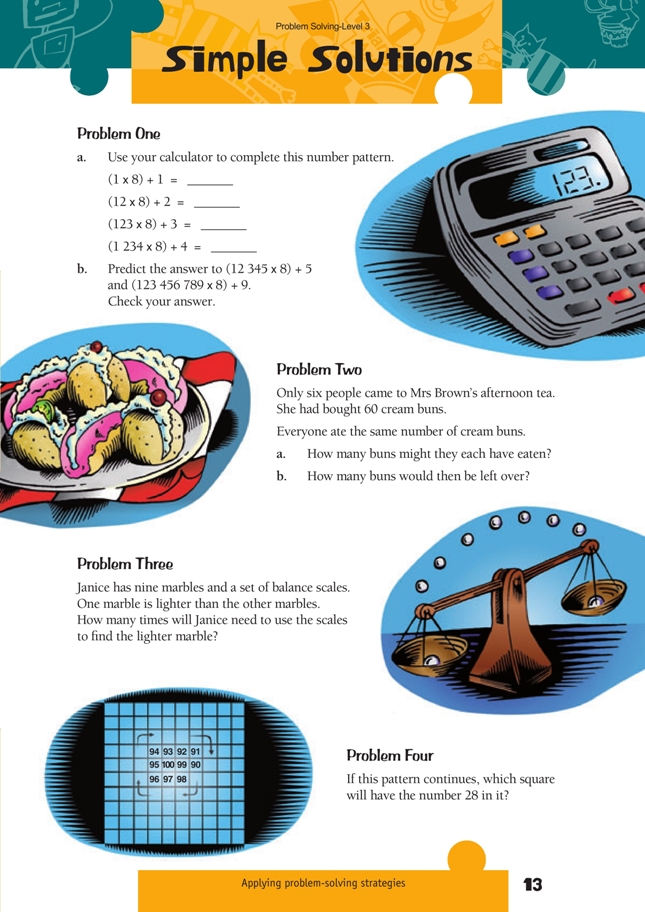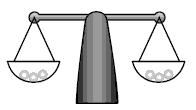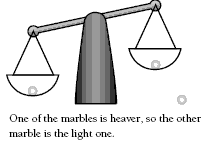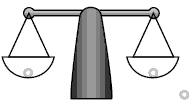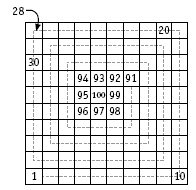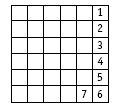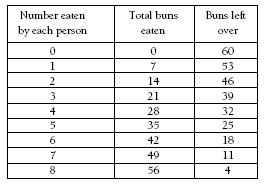These are level 3 algebra and number problems from the Figure It Out series.
A PDF of the student activity is included.
Click on the image to enlarge it. Click again to close. Download PDF (235 KB)
look for number patterns in puzzles (Problem 1)
use multiplication facts to solve problems (Problem 2)
Problem One
Students should observe a recursive (one after the other) pattern in the digits in this set of equations.
.gif)
As anticipated, the solution to the next equation follows the pattern:
(12 345 x 8) + 5 = 98 765.
Students can use two different strategies to predict the solution to (123 456 789 x 8) + 9.
1. Use recursion by continuing the set of equations:
.gif)
2. Direct reasoning:
.gif)
The answer has the same number of digits as the initial number, but starts with 9 and continues down.
Problem Two
Students will need to remember to include Mrs Brown as the seventh person when solving this problem. Some students may need equipment to model the problem. However, encourage students to use number facts to find solutions. These could be organised in a list to simplify the problem (see the table in the answers section).
Students might investigate the patterns for various numbers of guests, for example, 24 people and 60 buns.
Problem Three
This problem assumes students are aware of how balance scales work. Their most likely experience with a balance will be the use of a see-saw. Students will know that when two people are of similar mass, the see-saw is well balanced and easy to operate. If one person is heavier, their end of the seesaw has a greater force downwards.
Janice’s problem can be modelled with multilink cubes, with eight of one colour representing the marbles of equal mass and one cube of another colour representing the lighter marble. Students can then trial various weighing scenarios to test the effectiveness of each scenario in finding the lighter marble.
Janice’s problem can be solved in just two weighings. The nine marbles are separated into three sets of three marbles. Two of these sets are placed on the scales. Either of two things will occur:
The scales balance, so the lighter marble is in that set of three.
.gif)
One set of three is lighter, so the light is in the other set of three.
Put two of the marbles from the lighter set of marbles on the scales, one at each end. Either of two things will happen:
One of the marbles is heaver, so the other Tmarble is the light one.
The scales balance, so the marble not on the scales is the lightest.
Students might like to investigate the minimum weighings needed for different numbers of marbles when one is light. For example, with 12 marbles, three weighings are needed. Split the 12 marbles into three sets of four and weigh two of the sets. This will tell which set of four marbles the lighter one is in. In a maximum of two more weighings, the light marble can be found. This process can be demonstrated in a flow chart.
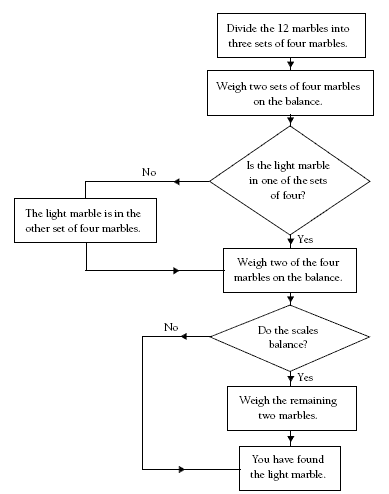
Problem Four
This problem is ideal for applying the strategy of working backwards. It would be tempting to continue the number pattern as it spirals around, but finding the square that will have one in it can make the solution easier.
Following the spiral pattern will show you where one is. Note that the spiral back to the position of one does not involve counting. A path of descending digits can be traced without naming the digits. From the position of one, it is easy to establish the position of 10, 20, and 30, using the fact that each row and column of the grid has 10 squares. The number 28 can be found by working back from 30.
Students may enjoy inventing other number grid puzzles for someone else to solve. For example:
Which square will have the number 35 in it?
Answers to Problems
1. a. (1 x 8) + 1 = 9
(12 x 8) + 2 = 98
(123 x 8) + 3 = 987
(1 234 x 8) + 4 = 9 876
b. (12 345 x 8) + 5 = 98 765
(123 456 789 x 8) + 9 = 987 654 321 (If you are checking this on your calculator, note that calculators that only fit 8 digits on the screen show the answer as 98765433.)
2. Note that, including Mrs Brown, there were 7 people present.
3. To get a sure result, only 2 weighings are needed, based on weighing groups of 3 marbles. You could take the risk of weighing 2 lots of 4, and if they balance, the ninth ball is the light one, and no more weighings are needed. However, if this is not the case, more than 2 weighings are necessary.
4. Top left-hand corner square
